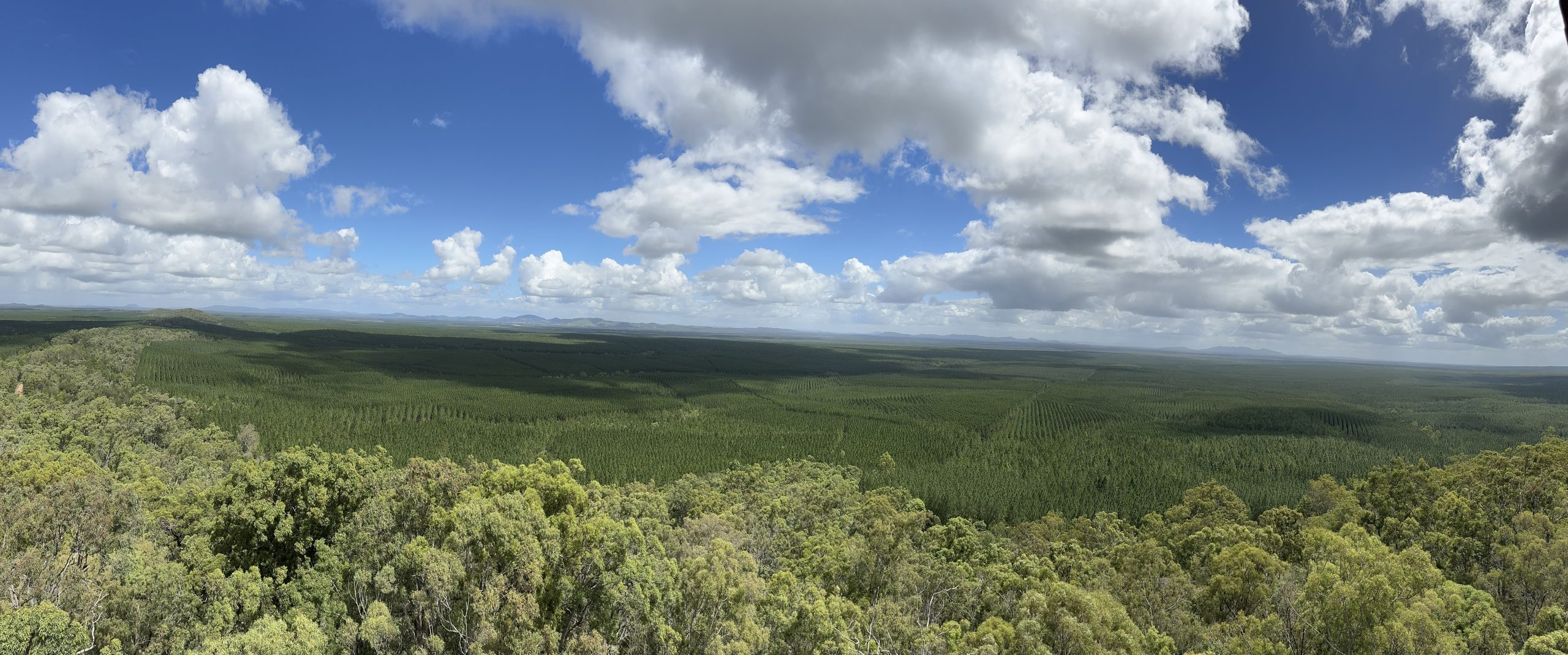The rise in global temperatures and increasingly frequent extreme weather events are undeniable signs of our rapidly changing climate. One of the most devastating outcomes of this shift is the increasing number and intensity of wildfires worldwide.
As wildfires become a significant threat, effective and sustainable forest management is more critical than ever. Responsible management protects ecosystems and builds resilience to wildfires, helping safeguard communities, biodiversity, and crucial resources.
Traditionally, wildfire strategies have focused on suppression after the fires start. However, a more proactive approach, emphasizing prevention and mitigation, is now essential.
The following sections will explore how sustainable forest management is crucial in enhancing wildfire resilience. We will also examine how exci’s AI early wildfire detection technology transforms wildfire management.
Building Forest Resilience with Sustainable Management
Forests offer far more than timber. They support essential ecosystems, providing carbon sequestration and water filtration services. These benefits maintain biodiversity and regulate the climate. Yet, as global temperatures rise, forests face growing threats from wildfires, deforestation, and degradation.
Sustainable forest management is key to addressing these challenges. Maintaining forest health strengthens their ability to serve as natural buffers against wildfires. So, how can we enhance wildfire resilience through strategic forest management?
Mitigation Strategies for Forest Health
Fire breaks are a vital tool in managing wildfires. These strategically cleared areas act as barriers, slowing or stopping the spread of fires by removing or reducing flammable materials. Fire breaks protect lives, property, and natural resources by creating zones where fire can no longer move quickly. They can be natural, such as rivers, rocky terrains, or man-made, through vegetation clearing. These barriers are critical in any comprehensive wildfire management and prevention strategy.
![]() BLM Idaho Prescribed Fire. Image source: rawpixel
BLM Idaho Prescribed Fire. Image source: rawpixel
Selective harvesting (or selective logging) is another sustainable forestry practice that balances economic goals with conservation efforts. This approach minimises environmental impact and helps maintain the forest’s overall health and biodiversity by carefully selecting and removing specific trees rather than clear-cutting entire areas. Selective harvesting supports sustainable timber production while ensuring forests remain resilient to wildfires.
 Selective harvesting. Image by Sam Beebe via Flickr
Selective harvesting. Image by Sam Beebe via Flickr
Similarly, tree spacing and thinning are essential management techniques that reduce wildfire risk. When trees are spaced further apart, flames have less fuel to spread, making it easier to control fires. Tree thinning, where specific trees are removed to reduce overcrowding, also helps to minimise fuel loads, improving forest health and making firefighting efforts safer and more effective.
In addition, planting fire-resilient tree species enhances forest fire resistance. Certain species, such as Eastern White Pine and Coast Redwoods, have natural defences like thick bark or high moisture content, making them more capable of withstanding fires. By planting these resilient species, forest managers can reduce the overall intensity and spread of wildfires, providing better protection for forests and nearby communities.
As climate change leads to frequent pest outbreaks, integrated pest management becomes essential for maintaining forest health. Pests like bark beetles weaken trees, making them more susceptible to fires. Monitoring and controlling pest populations can significantly reduce fire risks.
 Forest entomologist Mike Johnson with the Blue Mountains Forest Insect and Disease Service Center. Source: flickr by USDA Forest Service
Forest entomologist Mike Johnson with the Blue Mountains Forest Insect and Disease Service Center. Source: flickr by USDA Forest Service
Finally, technology plays a pivotal role in modern wildfire management. Remote sensing, satellite imagery, and AI, such as exci’s AI early wildfire detection system, provide real-time data and insights into forest conditions. These tools allow forest managers to monitor vegetation health, track high-risk fire areas, and respond swiftly to changing conditions, significantly enhancing wildfire prevention and mitigation efforts.
Case Studies of Sustainable Forest Management
Sustainable Forest Management in the Amazon Rainforest (Brazil)
Approach: In the Brazilian Amazon, sustainable forest management projects aim to reduce deforestation and promote responsible land use. The Amazon Sustainable Landscapes Program (ASL) integrates conservation, reforestation, and the sustainable use of natural resources to protect the region’s rich biodiversity.
Key Actions: The project promotes agroforestry, where crops like cocoa are grown alongside native trees, and encourages selective logging practices to minimise environmental impact. In partnership with The Nature Conservancy (TNC), Amazon Inc. is helping 3,000 small farmers adopt agroforestry, boosting local economies while protecting the forest.
Impact: This initiative plans to restore 20,000 hectares of rainforest over three years, sequestering up to 10 million tons of carbon over the next 30 years. By working with local communities, the project reduces deforestation, creates sustainable income for farmers, and preserves biodiversity. Carbon finance will support the initiative, generating high-quality offsets for Amazon Inc., aligning with its decarbonisation goals and contributing to global climate efforts.
Community-Based Forest Management in Nepal
Approach: Nepal’s community forestry model gives local communities the legal rights and responsibility to manage and protect their forests. This approach empowers communities to ensure sustainable forest practices while preserving their resources.
Key Actions: Communities focus on afforestation, controlled grazing, and the sustainable harvesting of timber and non-timber products. They also take proactive steps to reduce forest fires and combat erosion, ensuring long-term forest health.
Impact: Forest coverage in Nepal has increased over the years, and biodiversity has been protected. It has also provided local communities with sustainable income sources, strengthened social cohesion, and reduced poverty–all while promoting forest conservation.
Forest Stewardship Council (FSC) Certification Worldwide
Approach: The Forest Stewardship Council (FSC) promotes sustainable forest management globally, ensuring that timber harvesting is done responsibly while minimizing environmental and social impacts. With over 200 million hectares of forests certified worldwide, FSC is crucial in preserving biodiversity across diverse ecosystems.
Key Actions: FSC-certified forests adhere to strict guidelines to maintain biodiversity, protect endangered species, and involve Indigenous communities in decision-making. Mandatory replanting and regeneration ensure long-term forest health and sustainability.
Impact: FSC certification has led to measurable improvements in biodiversity conservation, reduced deforestation, and more sustainable timber production. Indigenous involvement has enriched forest management by integrating traditional ecological knowledge and strengthening conservation efforts worldwide.
Sustainable Forest Management in the Wet Tropics (Australia)
Approach: The Wet Tropics Management Authority (WTMA) has introduced a climate adaptation plan to address the impacts of climate change on the 900,000 hectares of tropical rainforest in the Wet Tropics of Queensland. This region, home to ancient rainforests and rich biodiversity, faces challenges similar to coral reef bleaching, making sustainable management essential for preserving both the ecosystem and Indigenous cultural heritage.
Key Actions: WTMA collaborates closely with Indigenous communities, particularly the Rainforest Aboriginal Peoples, to integrate traditional ecological knowledge into forest management. The authority also prioritizes controlling invasive species, restoring damaged ecosystems, and monitoring climate change effects on the rainforest.
Impact: The sustainable management of the Wet Tropics has preserved its biodiversity, supported Indigenous communities, and created sustainable tourism opportunities. By working together, WTMA and local Aboriginal groups have improved forest health and strengthened cultural ties. Critical ecosystem services, such as water regulation and carbon sequestration, are also being maintained.
Challenges to Forest Management and Wildfire Resilience
Sustainable forest management (SFM) seeks to balance ecological preservation with human needs, but it faces significant challenges as climate change and wildfire risks increase:
Resource Constraints: Implementing SFM requires substantial financial and human resources for monitoring, tree thinning, and prescribed burns. Many regions lack the infrastructure and funding to carry out these practices effectively.
Fragmented Land Ownership: In many areas, forests are managed by private, public, and Indigenous groups, creating a patchwork of responsibilities. Without stakeholder coordination, efforts to create fire-resilient landscapes can be inconsistent and ineffective.
Changing Fire Regimes: Climate change has altered fire patterns, making traditional fire management strategies obsolete. Adaptive management, which requires real-time data and long-term planning, is now essential.
Urban Expansion: As cities grow into wildland-urban interfaces (WUI), the risk of fires spreading from forests to communities increases. Managing these areas demands balancing urban protection with forest conservation.
Historically, wildfire management has focused on suppression rather than prevention, but the escalating climate crisis demands a more proactive approach. Preventive measures, sustainable management, and collaboration are essential to reducing wildfire risks and protecting ecosystems and communities.
exci’s AI Wildfire Detection: Faster, Smarter, Safer
While sustainable forest management builds resilience, early wildfire detection can prevent fires from spreading uncontrollably. Australian-made and owned, exci’s AI bushfire detection system leads the way in innovative wildfire management. Harnessing advanced AI and deep machine learning algorithms, exci’s technology analyses data from ground-based cameras and satellites to detect smoke and heat quickly and accurately, ensuring rapid and accurate wildfire/forest fire detection.
Our cutting-edge, camera-agnostic system integrates with various cameras, giving customers unparalleled control over their surveillance setups. exci’s system empowers users with real-time movement and zoom capabilities, allowing for precise fire assessment and live streaming access. This essential temporal element provides immediate and accurate situational awareness critical for effective fire management.
Customers can access the live camera feeds when exci’s AI detects a fire, facilitating real-time assessments and swift decision-making. This immediate access is crucial for supporting quick responses and initial attack efforts.
exci’s AI-driven bushfire technology provides forest managers, emergency services, and local authorities with critical lead time, enabling them to respond to fires within minutes of ignition. The system is scalable and adaptable to various environments, including forests, agricultural land, and infrastructure like powerlines.
Where exci’s system has been deployed, rapid detection and response have proven effective in reducing bushfire impacts and safeguarding forests and surrounding communities. With exci’s camera-agnostic AI, users benefit from high-accuracy forest fire detection tailored to their operational requirements, enhancing situational awareness and response capabilities.
Conclusion: A Holistic Approach to Wildfire and Forest Management
As wildfires become more frequent and intense, sustainable forest management has evolved from an environmental necessity to a critical strategy for building resilience against climate risks. We can protect ecosystems and reduce wildfire risks by integrating modern technology, traditional knowledge, and collaborative approaches.
Proactive measures such as sustainable forest management, combined with innovative technologies like exci’s AI-powered wildfire detection technology, offer a promising way forward. Implementing the right tools and strategies can strengthen forest resilience and protect these vital ecosystems, even as climate conditions become increasingly unpredictable.
by Gabrielle Tylor
exci AI – Smoke Alarm for the Bush
AI Wildfire & Bushfire Detection Technology
Don’t Let Hazardous Events Escalate into Catastrophes!
Reach out to our friendly team today for a comprehensive demonstration of exci’s system and learn how it can safeguard your assets while protecting your community.
email: info@exci.ai
International Phone: +61 458 594 554
Visit our website at https://www.exci.ai/ to learn more and take the first step towards a safer and more resilient future.

